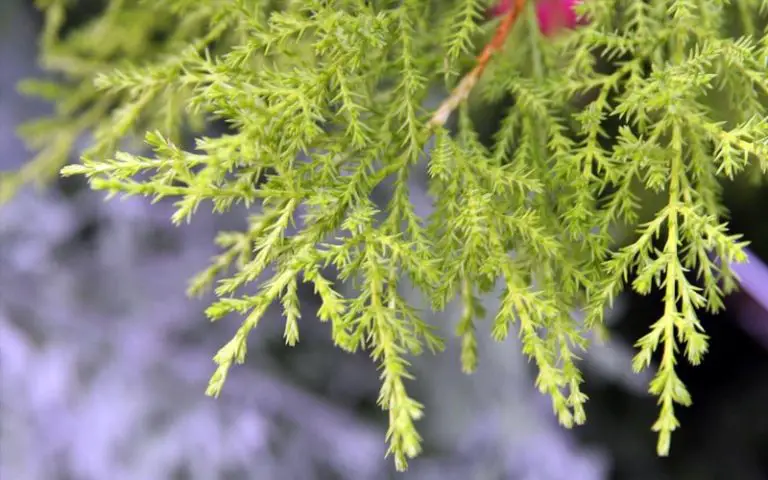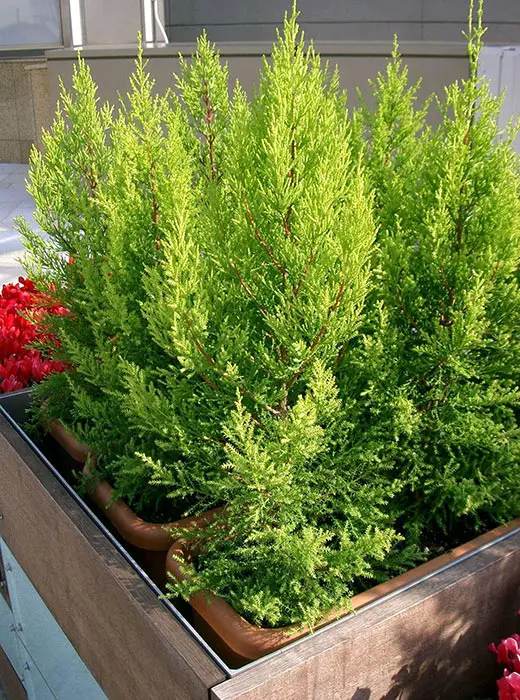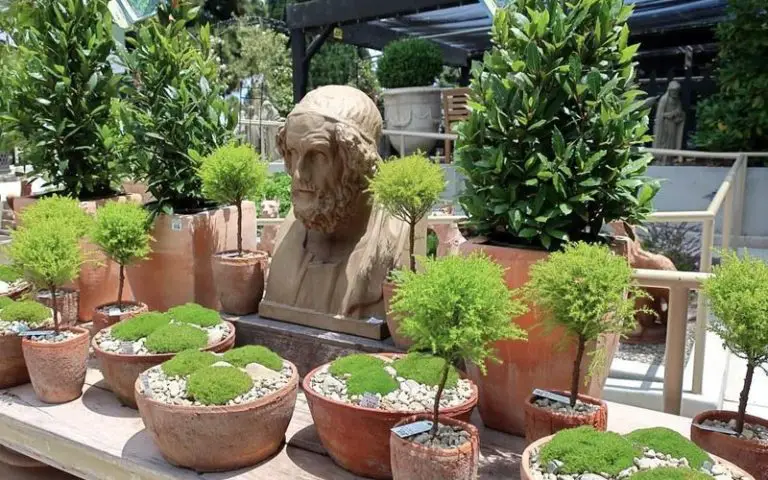Cupressus Macrocarpa Goldcrest Care Guide

Image courtesy of ShareAlike 4.0 International
The Cupressus Macrocarpa Goldcrest, also known as the “Wilma Goldcrest” Monterey Cypress, is a large outdoor tree. For bonsai enthusiasts, this massive tree is a prize worth cultivating thanks to its interesting leaf pattern. In both nature and your home, the species spikes to the sky in a vibrant green.
Here's what you'll find in our Cupressus Macrocarpa Goldcrest care guide:
Here's what you'll find in our Cupressus Macrocarpa Goldcrest care guide:
Quick Cupressus Macrocarpa Goldcrest Bonsai Care Sheet
Before heading into the detailed explanation on how to care for a Monterey Cypress
Recommended soil
All-purpose potting mix works well for the bonsai. The mixture should be fast draining.
Watering
Thorough watering but allow the soil to dry between waterings.
Potting season
Every four years.
Shaping and pruning season
Between April and August.
Light
6-8 hours minimum exposure to sunlight.
Fertilizing
Not recommended in most situations.
Propagation methods
A portion of the branch that’s between 4 and 8 inches long.
Pests and diseases
Cypress aphid, scales, bark beetles, caterpillars, sawflies, bark moth, and Cypress tip miner. Honey fungus, brown patches.
Growth patterns
Cone-shaped.
Recommended styles
All styles.
Scientific Classification
- Clade: Tracheophytes
- Order: Conifers
- Family: Cupressaceae
- Genus: Cupress
- Species: C. macrocarpa cv. Gold Crest
How to Care for a Cupressus Macrocarpa Goldcrest Bonsai
The Monterey cypress is easy to care for indoors and only truly needs maintenance in pruning. This tree requires plenty of sunlight if you’re planting it indoors or outdoors and should be repotted every four years. Unfortunately, the conifer isn’t without its pests or disease potential.
Best Soil
When planting a Lemon Cypress bonsai, it’s best to avoid rich soil as it’s adapted for growth in less fertile and well-draining soil. The tree is hardy and doesn’t require expensive or any overtly fancy dirt.
The bonsai can survive in poor and infertile soil conditions. This soil variety allows the roots to match the bonsai’s roots in growth speed as it begins to grow. The benefit of enabling roots to grow freely comes when most winds move or push over the bonsai.
Watering
While the plant needs little watering as an outdoor shrub, the bonsai is different. You’ll need to give it a thorough watering that penetrates deep to the roots at least every few days.
While watering your bonsai, you should be able to see the soil is soaked and wet. The easiest way to determine when you require water again is by judging when the soil is dry. Once the top layer of soil is free of moisture, you can repeat the watering process.
Repotting
Repotting any bonsai is necessary as it grows and can eventually have roots larger than the current pot or container. Doing this every three to four years is highly recommended to prevent any damage from happening with your bonsai’s roots. Additionally, if you suspect that the roots have reached the bottom of your pot, it may be time to repot the conifer early.
When repotting, it’s ideal to use the same form of soil. The dirt that’s best suited to a Monterey cypress isn’t rich or filled with organic fertilizer. Ensuring the new pot and soil allow for adequate water drain is also essential.
Shaping and Pruning
The natural shape of the Monterey Cypress is a cone. For the most part, this shape never requires pruning unless it’s getting too large. We recommend that if you trim your conifer bonsai, be careful as pruning too much may damage your bonsai.
Location and Sunlight
If you’re keeping your Monterey cypress bonsai inside your house, it’s essential to make sure it’s in a position to receive the most sunlight possible. For the best benefit, ensure that the plant gets at least 6-8 hours of daylight each day.
Without this optimal amount of sunlight, the conifer can suffer and grow poorly. Keeping it will require a well-lit room for most of the day. This requirement makes it less suited for home offices or kitchens where there is minimal exposure to sunlight.
Fertilizing
The Cupressus Macrocarpa Goldcrest is a hardy plant that doesn’t require much aid from fertilizers. In most cases, we recommend avoiding fertilizer use and simply picking excellent soil for planting the bonsai tree.
The worst fertilizer choice for a conifer tree is a rich organic option. The cypress is adapted for infertile soil that’s often low in nutrients. As such, we recommend using no fertilizer at all when potting your bonsai.
Propagation Methods
A Cupressus Macrocarpa Goldcrest can be propagated from a portion of the cypress’s branch. This cut-off branch needs to have a length of at least four inches. With the most significant cut-off measuring 8 inches in size, the conifer piece is well-suited to become a bonsai.
Wound the cut branch deeply, ensuring the cambium or the thin layer between the bark and wood are exposed. This wounding stimulates the development of new roots for your bonsai.
Pests and Diseases
Unfortunately, the Cupressus Macrocarpa Goldcrest has several pests that enjoy destroying your bonsai. These pests include aphids, scales, bark beetles, caterpillars, sawflies, bark moths, and Cypress tip miners. This large variety of insects and pests leave the bonsai needing frequent observation.
As for diseases, there’s less to worry about. As long as you take care of the plant, you’ll avoid any conditions. However, the conifer is prone to honey fungus and brown spots in particular.
Growth Patterns
The Cupressus Macrocarpa Goldcrest bonsai grows in a cone shape, pointing itself to the sky. This shape is often considered unusual for a bonsai but makes it a great option if your spacing is limited.
The cone shape and leaves result in the nickname of lemon cypress, as the leaves leave a lemony scent after being brushed through.
Recommended Styles
When growing this bonsai, you don’t need to worry about the style. The plant is hardy and can survive alone or in a group with other trees of the same species. However, if you’re growing a large amount of these bonsais next to each other, it’s essential to ensure they don’t block sunlight on each other.
The roots need a lot of water, and thus it’s essential to keep the base in the soil as much as possible. The plant is hardy and will endure many.

Image courtesy of ShareAlike 3.0 Unported
Considerations for Growing an Indoor Cupressus Macrocarpa Goldcrest
Growing a Cupressus Macrocarpa Goldcrest bonsai indoors is a great idea. However, there are a few things to consider beforehand that affect how well the plant grows. The most significant consideration is how often you water it and the amount of sunlight it will receive.
Light
The Cupressus Macrocarpa Goldcrest needs a large amount of sunlight to thrive. Without this light, you’ll quickly find your bonsai in a state of near-death. If your home doesn’t have an area that receives at least six hours of sunlight a day, you’ll need to either continuously move the pot or consider a different bonsai tree.
Attention
The watering schedule for a lemon cypress is a bit strange. You’ll need to check if the soil is dry and draining well every few days. If the soil is dry, it’s time to water the bonsai again.
Temperature
Lemon cypress plants prefer a cooler temperature. Ideally, 55-65 degrees Fahrenheit is the best temperature if you’re keeping one of these conifers indoors.
Common Issues When Caring For a Cupressus Macrocarpa Goldcrest Bonsai
Unfortunately, we know growing and caring for a bonsai is never an easy task. Bonsai trees are a beauty to behold and require lots of care. These are issues that many have experienced while beginning to grow their first conifer bonsai.
Placement
The location you keep a lemon cypress is one of the essential elements of growing it. If you have the tree in the wrong spot, the Cupressus Macrocarpa Goldcrest can wither. Exposure to sunlight is a must for the Monterey, and without it, the soil won’t dry as fast as needed either.
Pot size
Cupressus Macrocarpa Goldcrest roots can grow deep, ensuring that the plant is stable and can grow quickly. However, you’ll need to repot it onto a larger container every four years due to this root size.
Interesting Facts
The Cupressus Macrocarpa Goldcrest tree has many interesting facts, which may change how you consider potting it or whether you pick it as your following bonsai to cultivate.
- If the leaves are crushed or rubbed, they emit a slight lemon scent. This results in the plant’s nickname “lemon cypress.”
- The goldcrest variety of this species is the most common.
- Monterey cypresses grow fast and can quickly reach heights above six feet.
- The plant requires large or deep pots due to its root structure.

Image courtesy of 2.0 Generic
FAQs
Should you have any lingering uncertainty, we’ve taken the opportunity to answer many of the frequently asked questions. Many of these are commonly searched by bonsai lovers or have previously been asked for by readers. If you’re still uncertain about any bonsai, please send it to us.
A fully grown macrocarpa tree can reach heights above 43 yards. However, you don’t need to worry about bonsai trees reaching this height with careful pruning and careful maintenance.
Yes, it is entirely possible to grow a bonsai from a Monterey cypress. While the act of propagating a conifer requires patience, it can quickly grow as a bonsai. However, the plant will grow in a shape that is untraditional of most bonsais.
The best way to care for a macrocarpa Cupressus bonsai is to view all the information above. Unfortunately, there’s no quick way to take care of a bonsai, but getting the soil and watering right is an excellent step in the right direction.
The Cupressus Goldcrest grows remarkably fast and can reach speeds of an added 15 to 23 inches of height annually. For normal conifers, this speed often stops when they get a height of 6 feet. However, with careful pruning and patience, the bonsai will grow slower and never appear to be oversized.
Shade is not the ideal place to put any Goldcrest bonsai in your home. Goldcrests require plenty of sunlight and, at most, can survive in partial shade. For the best growth of your Goldcrest, between 6-8 hours of daylight a day is recommended.
In general, the large variety of macrocarpa trees can live for nearly 2,000 years. However, based on evidence, the oldest reported macrocarpa tree is over 280 years. Unfortunately, for a tree to live this long and surpass multiple generations, it needs ideal conditions. These conditions include sunlight exposure and climate.







